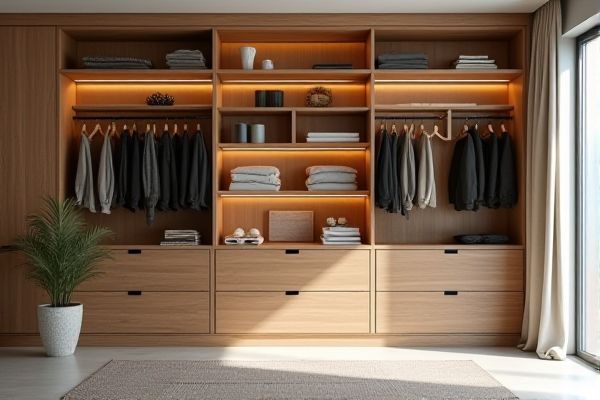
Display shelving emphasizes aesthetics and accessibility, designed to showcase items attractively in open spaces, while storage shelving in closets prioritizes maximizing space and organization for less frequently accessed belongings. Enhance Your storage strategy by understanding the differences and choosing the right shelving solution for your needs--read on to explore detailed comparisons and tips.
Table of Comparison
| Feature | Display Shelving | Storage Shelving (Closet) |
|---|---|---|
| Purpose | Showcases items for easy access and visual appeal | Organizes and stores items out of sight for space optimization |
| Design | Open shelves, often decorative and accessible | Enclosed or semi-enclosed with doors or panels |
| Material | Wood, glass, metal with aesthetic finishes | Wood, laminate, metal built for durability and storage capacity |
| Visibility | High visibility for items displayed | Low visibility; items hidden from view |
| Accessibility | Quick access to frequently used or decorative items | Access varies; often for less frequently used items |
| Ideal Use | Retail stores, living rooms, kitchens for decor and essentials | Bedrooms, utility rooms, closets for organized storage |
| Customization | Flexible sizes and arrangements to fit decor | Modular systems with adjustable shelves and compartments |
Introduction to Display Shelving vs Storage Shelving
Display shelving emphasizes aesthetics and accessibility, designed to showcase items prominently in retail or living spaces. Storage shelving, commonly used in closets, prioritizes maximizing space and organization to keep belongings neatly arranged and out of sight. The choice between these shelving types depends on whether visibility or functionality is the primary goal.
Purpose and Functionality: Display vs Storage
Display shelving emphasizes showcasing items with open designs that enhance visibility and accessibility, often used in retail or living spaces to highlight decor or merchandise. Storage shelving in closets prioritizes organization and space efficiency, featuring enclosed or adjustable compartments that securely hold clothing, accessories, and personal belongings. The main functional difference lies in display shelving's aesthetic appeal and easy access versus storage shelving's focus on protecting and categorizing items for long-term use.
Design and Aesthetics Differences
Display shelving emphasizes open, visually appealing designs that highlight decorative items and enhance room aesthetics with clean lines and stylish materials. Storage shelving in closets prioritizes functionality, often featuring enclosed or adjustable compartments to maximize space and keep belongings organized and out of sight. Your choice between the two depends on whether visual impact or practical storage is the primary goal.
Materials Used in Display and Storage Shelving
Display shelving commonly utilizes materials like tempered glass, polished wood, and metal alloys to enhance aesthetic appeal while ensuring durability and visibility of showcased items. Storage shelving in closets often features engineered wood, heavy-duty steel, and melamine surfaces designed for strength, moisture resistance, and maximizing space efficiency. Both types prioritize material properties tailored to their specific functions: display shelving focuses on visual presentation, and storage shelving emphasizes load-bearing capacity and organizational practicality.
Space Optimization: Display vs Closet Storage
Display shelving maximizes space by showcasing items visibly and accessibly, enhancing organization through open design that encourages efficient use of vertical and horizontal areas. Closet storage shelving prioritizes concealed storage with adjustable compartments, optimizing space for varied items via customizable depth and height to accommodate clothing and accessories efficiently. Efficient space optimization depends on choosing open display shelves for visibility and quick access or enclosed closet shelving for maximizing hidden, compact storage capacity.
Accessibility and Organization
Display shelving offers easy accessibility by keeping items visible and within reach, ideal for frequently used or decorative items, enhancing organization through visual categorization. Storage shelving in closets provides a more concealed and systematic approach, allowing your belongings to be grouped and stored out of sight, optimizing space and reducing clutter. Choosing between the two depends on whether quick access or discreet storage best suits your organizational needs.
Customization Options for Each Type
Display shelving offers extensive customization options that cater to aesthetic preferences and product visibility, including adjustable shelf heights, integrated lighting, and varied materials such as glass or metal for enhanced presentation. Storage shelving for closets emphasizes functional customization features like modular units, pull-out drawers, hanging rods, and adjustable compartments to maximize space efficiency and organization. Both shelving types can be tailored, but display shelves prioritize design flexibility, whereas storage shelves focus on optimizing storage capacity and accessibility.
Durability and Maintenance Comparison
Display shelving, often crafted from tempered glass, metal, or high-quality wood, balances aesthetic appeal with moderate durability designed for frequent visibility and light use, requiring regular dusting and careful cleaning to maintain its appearance. Storage shelving in closets is typically constructed from sturdier materials such as solid wood, heavy-duty metal, or reinforced plastic, engineered to withstand heavy loads and frequent access, demanding less frequent maintenance but occasional tightening of fasteners and surface cleaning. The durability of storage shelving generally surpasses that of display shelving due to its structural emphasis, while maintenance varies based on material and usage intensity, with display shelves needing more delicate care to preserve visual clarity.
Cost Considerations
Display shelving typically costs more due to its design emphasis on aesthetics, featuring open, polished materials that enhance product visibility and appeal. Storage shelving for closets prioritizes functionality and durability, often made from budget-friendly materials like metal or wood composites, resulting in lower upfront costs. Choosing the right shelving depends on your budget balance between visual presentation and practical storage needs.
Choosing the Right Shelving for Your Needs
Choosing between display shelving and storage shelving depends on whether you prioritize visibility or organization. Display shelving highlights items like decor or merchandise, enhancing aesthetics and easy access, while storage shelving in closets maximizes space efficiency and keeps belongings neatly concealed. Your choice should align with the function and style of the room to optimize both utility and appearance.
 homyna.com
homyna.com